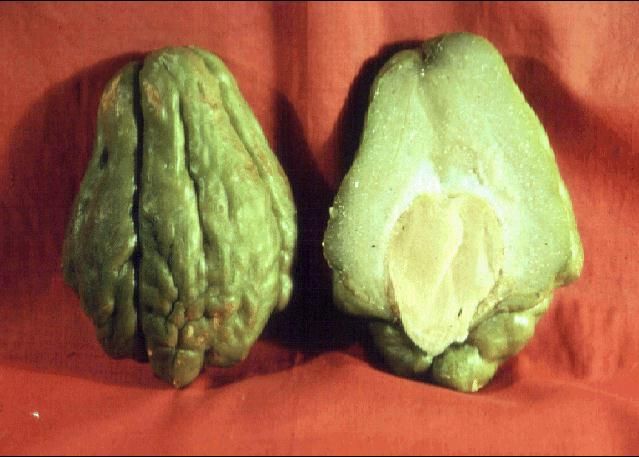Chayote—Sechium edule (Jacq.) Sw.1
The chayote has been grown to a limited extent in Florida for many years. While native to Guatemala, it is popular throughout tropical regions where it is known by several names including vegetable pear, mirliton, and mango squash.
Description
Chayote is a tender, perennial-rooted cucurbit, with climbing vines and leaves resembling those of the cucumber. The light green, pear-shaped fruit, which contains a single, flat edible seed, may weigh as much as 2 to 3 pounds, but most often is from 6 to 12 ounces. While fruits may be slightly grooved and prickly, those grown in Florida are usually smooth.

Credit: Blue Goose, Inc.
Culture
While an edible tuberous root forms below the crown, it is the fruit for which the plant is grown. Since it is perennial, the best production is obtained 2 to 3 years after the plant is established. The main varieties include 'Florida Green,' 'Monticello White,' and various imports.
Some type of trellis or support for the climbing vines is required. Most trellises in Florida are constructed about head-high to facilitate walking beneath the vines for harvesting and other operations.
The whole fruit is planted as a seed. Each fruit has a single large seed that sprouts as soon as the fruit reaches maturity unless placed in cool storage. Fruits stored at 50°F remain in good condition for planting for as much as 6 to 8 weeks, although shriveling and decay are common.
Plant one fruit per hill in hills spaced 12 feet apart and in rows spaced 12 feet apart. Place the fruit on its side with the smaller stem end sloping upward. While the stem end is usually left slightly exposed, in colder areas of Florida growers have found that the fruit should be completely covered with soil to protect the bud from early cold damage. Plant in the early spring in all areas of Florida or in the fall in south Florida.
Fertilizer should be applied in three applications: at planting time, in the middle of the summer, and when fruits are small. Fertilizing at more frequent intervals might be necessary when conditions warrant. Well rotted animal manures or composted materials are beneficial.
Both male and female flowers occur on the same vine. These flowers are visited by insects, both wasps and bees, which facilitate pollination. Fruits mature about 35 days following pollination.
Use
Chayote is served in many ways: creamed, buttered, fried, stuffed, baked, frittered, boiled, mashed, pickled, in salads, or in pies. Commercially, the biggest market appears to be for pickling.
Following harvest the fruits may be stored in edible condition for several weeks if wrapped in newspaper and kept cool (50–55°F). At room temperature, the fruit will shrivel and sprout.


